



Book a Free Consultation!
✅Builders CFO Program
✅Business Improvement Program
✅Taxation Advice


Creating an effective one-page plan for a business is essential for developing a strategy that works. With an OPP, you can quickly and easily summarise the current state of your business, as well as its future objectives and plans for success. By having a clear overview of your organisation’s goals and strategies, it will be easier to track progress and address any issues that may arise.
In this guide, we will explain the process of creating an OPP and how it can help you create a successful strategy.
If you’re already ready to get started on your OPP, download our FREE template to get planning NOW!
Table of Contents
- What is a One Page Plan [OPP]?
- Why it’s important?
- What should we include in an effective one-page plan?
- How do we measure success?
- What other tips do you have for creating an effective OPP?
- Download a FREE copy of our OPP template!
What is a One Page Plan [OPP]?
A one-page plan is a concise, focused document that outlines the overall goals and strategies of your business. It’s designed to give you (and other stakeholders) an overview of your organisation’s current state and future objectives on a single page. An OPP should be focused on action and outcomes, as well as measurable goals.
The goals of an OPP are to:
- Analyse and prioritise goals;
- Communicate business goals with staff;
- Identify smart key performance measurements;
- Set time frames and responsibilities for the competition of the actions, and;
- Review outcomes and adjust plans.
Why it’s important?
An effective one-page business plan can help you stay focused on the most important business objectives and business strategy of your business. It can also enable more efficient decision-making, as you’ll have a clear understanding of what needs to be done in order to reach your goals. Additionally, an OPP can help align the overall vision and strategies of an organisation with those of its members, allowing everyone to work together more effectively.
What should we include in an effective one-page plan?
When creating an OPP, there are a few key elements that should be included in order to ensure its effectiveness. These elements include:
1. WHERE do we want/need to be?
Who are your target customers?
Where do you want to be positioned in your market?
What are your short-term goals?
2. Where are we NOW?
Analyse the current state of your business and identify areas for improvement.
What are the key challenges that you currently have in achieving your goals?
Develop a list and prioritise the key challenges that your business is facing.
3. HOW are we going to move from where we are now to where we want/need to be?
Focusing on a short list of key challenges [3-4], develop SMART objectives targeted at overcoming these challenges. I.e.
Items that need to be completed in the short term that focus on our long-term goals.
For each objective, create a list of strategies and actions that will help achieve the goal.
4. Who is Responsible?
For each item listed in step 3, assign responsibility to the individuals or teams who are responsible for carrying out these tasks. Make sure to specify a timeline for completion (i.e. deadlines).
This is important to ensure that all tasks are completed in a timely manner and that everyone is held accountable.
How do we measure success?
We find that an OPP works best in 90-day cycles – short enough to trigger immediate actions and long enough to allow for some results. We would typically recommend that plans are reviewed and monitored monthly, with a detailed quarterly review.
In order to evaluate progress, it’s essential to set key performance indicators (KPIs) for each objective. These should be used to measure whether an organisation has reached its targets and goals.
For example, if a goal is to increase sales by 10%, then the KPI should reflect this – such as tracking the number of sales over a specific period of time. KPIs should be specific, measurable and achievable in order for them to provide useful data.
Measuring progress regularly will enable you to evaluate if your OPP is working and make any necessary adjustments.
Monthly Reviews – Serve to monitor and evaluate the progress and the status of the planned actions, and to review and discuss issues and roadblocks which may come to light.
Quarterly Reviews – This is a review of our WHERE & NOW, have our plans changed in light of new achievements or changing goals, can we work down the list of key challenges originally set and assign new actions and responsibilities to be achieved over the next 90 days?
These reviews should also be used to identify any new objectives that may arise due to changes in the market or organisation. This will enable your OPP to remain agile and relevant, and allow you to adjust accordingly if needed.
What other tips do you have for creating an effective OPP?
- Be as specific as possible when outlining your goals and objectives – the more detail the better!
- Make sure to allocate resources such as time, money and personnel to ensure success.
- Keep communication lines open with all stakeholders in order to get buy-in and ensure everyone is on board and clear on the vision and goals.
- Make sure to review your OPP regularly – at least quarterly or even monthly depending on the scope of your plan – in order to ensure progress is being made and objectives are being properly met.
- Take advantage of technology tools such as project management systems, task tracking/management systems, and automated reporting tools which can help you manage and track the progress of your OPP.
- Don’t forget to celebrate successes and review lessons learned from any mistakes or roadblocks encountered along the way. This will ensure that your team is motivated, inspired and focused on achieving even bigger goals in the future.
By taking these steps, businesses can create an effective one-page plan that will make it easier to define objectives, allocate resources and track progress. This will help organisations stay on track and ensure they reach the goals laid out in their OPP.
At the same time, it’s important to remember that creating an OPP is only the beginning. In order for it to be effective, organisations must also ensure they have the resources and personnel to execute the plan. With a well-executed OPP, businesses can help ensure their success in achieving their goals.
Conclusion
An effective one-page plan helps organisations reach their goals by providing a concise overview of their current state and future objectives. It should include an analysis of the current situation, measurable goals, actions for achieving these goals, and key performance indicators to measure progress. Additionally, organisations should ensure that they have the resources and personnel needed to execute the plan.
Download a FREE copy of our OPP template!
At Mead Partners, we have created a free one-page plan template. Our template provides all of the elements necessary for creating a successful OPP and can be used as a starting point when developing your own plan.
If you require further assistance feel free to contact our office for more information.
Download our FREE OPP template

Send To Someone